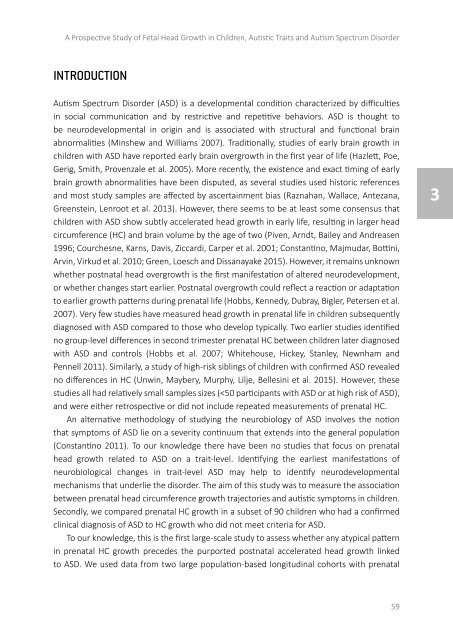On the Spectrum
2lm5UyR
2lm5UyR
You also want an ePaper? Increase the reach of your titles
YUMPU automatically turns print PDFs into web optimized ePapers that Google loves.
A Prospective Study of Fetal Head Growth in Children, Autistic Traits and Autism <strong>Spectrum</strong> Disorder<br />
INTRODUCTION<br />
Autism <strong>Spectrum</strong> Disorder (ASD) is a developmental condition characterized by difficulties<br />
in social communication and by restrictive and repetitive behaviors. ASD is thought to<br />
be neurodevelopmental in origin and is associated with structural and functional brain<br />
abnormalities (Minshew and Williams 2007). Traditionally, studies of early brain growth in<br />
children with ASD have reported early brain overgrowth in <strong>the</strong> first year of life (Hazlett, Poe,<br />
Gerig, Smith, Provenzale et al. 2005). More recently, <strong>the</strong> existence and exact timing of early<br />
brain growth abnormalities have been disputed, as several studies used historic references<br />
and most study samples are affected by ascertainment bias (Raznahan, Wallace, Antezana,<br />
Greenstein, Lenroot et al. 2013). However, <strong>the</strong>re seems to be at least some consensus that<br />
children with ASD show subtly accelerated head growth in early life, resulting in larger head<br />
circumference (HC) and brain volume by <strong>the</strong> age of two (Piven, Arndt, Bailey and Andreasen<br />
1996; Courchesne, Karns, Davis, Ziccardi, Carper et al. 2001; Constantino, Majmudar, Bottini,<br />
Arvin, Virkud et al. 2010; Green, Loesch and Dissanayake 2015). However, it remains unknown<br />
whe<strong>the</strong>r postnatal head overgrowth is <strong>the</strong> first manifestation of altered neurodevelopment,<br />
or whe<strong>the</strong>r changes start earlier. Postnatal overgrowth could reflect a reaction or adaptation<br />
to earlier growth patterns during prenatal life (Hobbs, Kennedy, Dubray, Bigler, Petersen et al.<br />
2007). Very few studies have measured head growth in prenatal life in children subsequently<br />
diagnosed with ASD compared to those who develop typically. Two earlier studies identified<br />
no group-level differences in second trimester prenatal HC between children later diagnosed<br />
with ASD and controls (Hobbs et al. 2007; Whitehouse, Hickey, Stanley, Newnham and<br />
Pennell 2011). Similarly, a study of high-risk siblings of children with confirmed ASD revealed<br />
no differences in HC (Unwin, Maybery, Murphy, Lilje, Bellesini et al. 2015). However, <strong>the</strong>se<br />
studies all had relatively small samples sizes (


